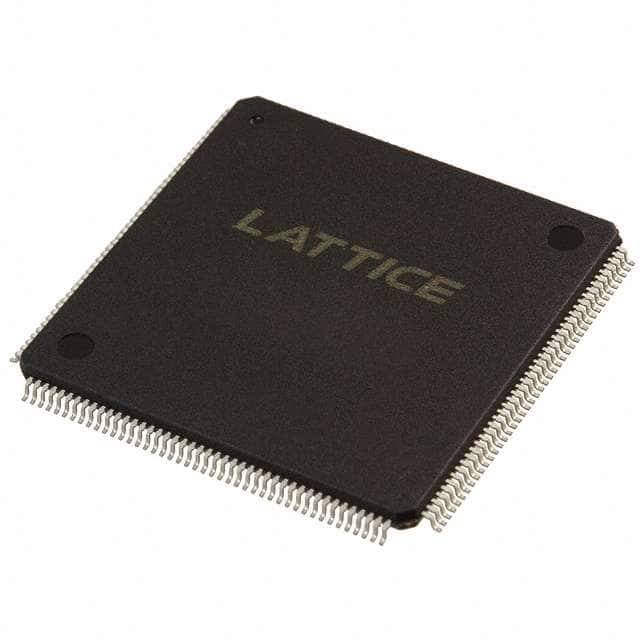Viz Specifikace pro podrobnosti o produktu.

LC4256V-75TN176C
Product Overview
Category: Integrated Circuit (IC)
Use: The LC4256V-75TN176C is a programmable logic device (PLD) that belongs to the family of Complex Programmable Logic Devices (CPLDs). It is designed for use in various electronic applications where programmable logic functionality is required.
Characteristics: - High-density CPLD with 256 macrocells - Low power consumption - Fast performance with high-speed internal clocking - Flexible and reprogrammable design - Wide range of I/O options - Supports various programming methods
Package: The LC4256V-75TN176C is available in a 176-pin Thin Quad Flat Pack (TQFP) package. This package provides ease of handling and compatibility with standard surface mount technology.
Essence: The essence of the LC4256V-75TN176C lies in its ability to provide programmable logic functionality in a compact and versatile package. It offers designers the flexibility to implement custom logic functions, making it suitable for a wide range of applications.
Packaging/Quantity: The LC4256V-75TN176C is typically supplied in tape and reel packaging, with a quantity of 250 units per reel.
Specifications
- Macrocell Count: 256
- Operating Voltage: 3.3V
- Speed Grade: -75
- Maximum Frequency: 75 MHz
- I/O Pins: 128
- Package Type: TQFP
- Package Pins: 176
Pin Configuration
The LC4256V-75TN176C has a total of 176 pins arranged in a specific configuration. The detailed pinout can be found in the product datasheet.
Functional Features
- High-density programmable logic capability
- Flexible I/O options for versatile connectivity
- Fast internal clocking for high-speed operation
- Reprogrammable design for easy updates and modifications
- Low power consumption for energy-efficient applications
- Wide range of supported programming methods for convenience
Advantages and Disadvantages
Advantages: - High-density macrocell count allows for complex logic designs - Flexible I/O options provide versatility in connectivity - Reprogrammable design enables easy updates and modifications - Low power consumption contributes to energy efficiency - Wide range of supported programming methods offers convenience to designers
Disadvantages: - Limited maximum frequency compared to some other programmable logic devices - Relatively smaller number of I/O pins compared to higher-end CPLDs
Working Principles
The LC4256V-75TN176C operates based on the principles of programmable logic. It consists of a matrix of configurable logic blocks (CLBs) interconnected by programmable interconnects. The CLBs contain look-up tables (LUTs), flip-flops, and other components that can be programmed to implement custom logic functions.
During operation, the device is programmed using specialized software tools that generate a configuration file. This file is then loaded into the LC4256V-75TN176C, configuring its internal logic according to the desired functionality. The programmed device can then perform the specified logic operations based on the input signals received.
Detailed Application Field Plans
The LC4256V-75TN176C finds application in various fields where programmable logic functionality is required. Some potential application areas include: - Industrial automation - Communications systems - Consumer electronics - Automotive electronics - Medical devices - Aerospace and defense systems
In these fields, the LC4256V-75TN176C can be used to implement custom logic functions such as data processing, control algorithms, signal routing, and more.
Alternative Models
For those seeking alternative options, the following CPLDs can be considered: - LC4128V-75TN144C - LC4032V-75TN48C - LC4064V-75TN100C
These models offer varying macrocell counts, package types, and pin configurations to suit different design requirements.
Seznam 10 běžných otázek a odpovědí souvisejících s aplikací LC4256V-75TN176C v technických řešeních
Sure! Here are 10 common questions and answers related to the application of LC4256V-75TN176C in technical solutions:
1. What is LC4256V-75TN176C? - LC4256V-75TN176C is a specific model of Field Programmable Gate Array (FPGA) manufactured by Lattice Semiconductor Corporation.
2. What are the key features of LC4256V-75TN176C? - Some key features of LC4256V-75TN176C include 256 macrocells, 75MHz maximum operating frequency, 3.3V power supply, and 176-pin Thin Quad Flat Pack (TQFP) package.
3. What are the typical applications of LC4256V-75TN176C? - LC4256V-75TN176C is commonly used in various technical solutions such as industrial automation, telecommunications, automotive electronics, medical devices, and consumer electronics.
4. How can LC4256V-75TN176C be programmed? - LC4256V-75TN176C can be programmed using Hardware Description Languages (HDLs) like VHDL or Verilog, which allow designers to describe the desired functionality of the FPGA.
5. Can LC4256V-75TN176C be reprogrammed after initial programming? - Yes, LC4256V-75TN176C is a reprogrammable FPGA, meaning it can be reconfigured multiple times to implement different designs or functionalities.
6. What tools are available for programming LC4256V-75TN176C? - Lattice Semiconductor provides software tools like Lattice Diamond or iCEcube2 that enable designers to program and configure LC4256V-75TN176C.
7. What is the power consumption of LC4256V-75TN176C? - The power consumption of LC4256V-75TN176C depends on the specific design and usage scenario. It is recommended to refer to the datasheet or consult Lattice Semiconductor for detailed power consumption information.
8. Can LC4256V-75TN176C interface with other electronic components? - Yes, LC4256V-75TN176C supports various interfaces such as GPIO (General Purpose Input/Output), SPI (Serial Peripheral Interface), I2C (Inter-Integrated Circuit), UART (Universal Asynchronous Receiver-Transmitter), etc., allowing it to communicate with other electronic components.
9. Are there any limitations or considerations when using LC4256V-75TN176C? - Some considerations include understanding the maximum operating frequency, available resources (macrocells, memory blocks, etc.), and ensuring proper power supply and cooling for reliable operation.
10. Where can I find more information about LC4256V-75TN176C? - You can find more information about LC4256V-75TN176C on the official website of Lattice Semiconductor Corporation or by referring to the datasheet and application notes provided by the manufacturer.

